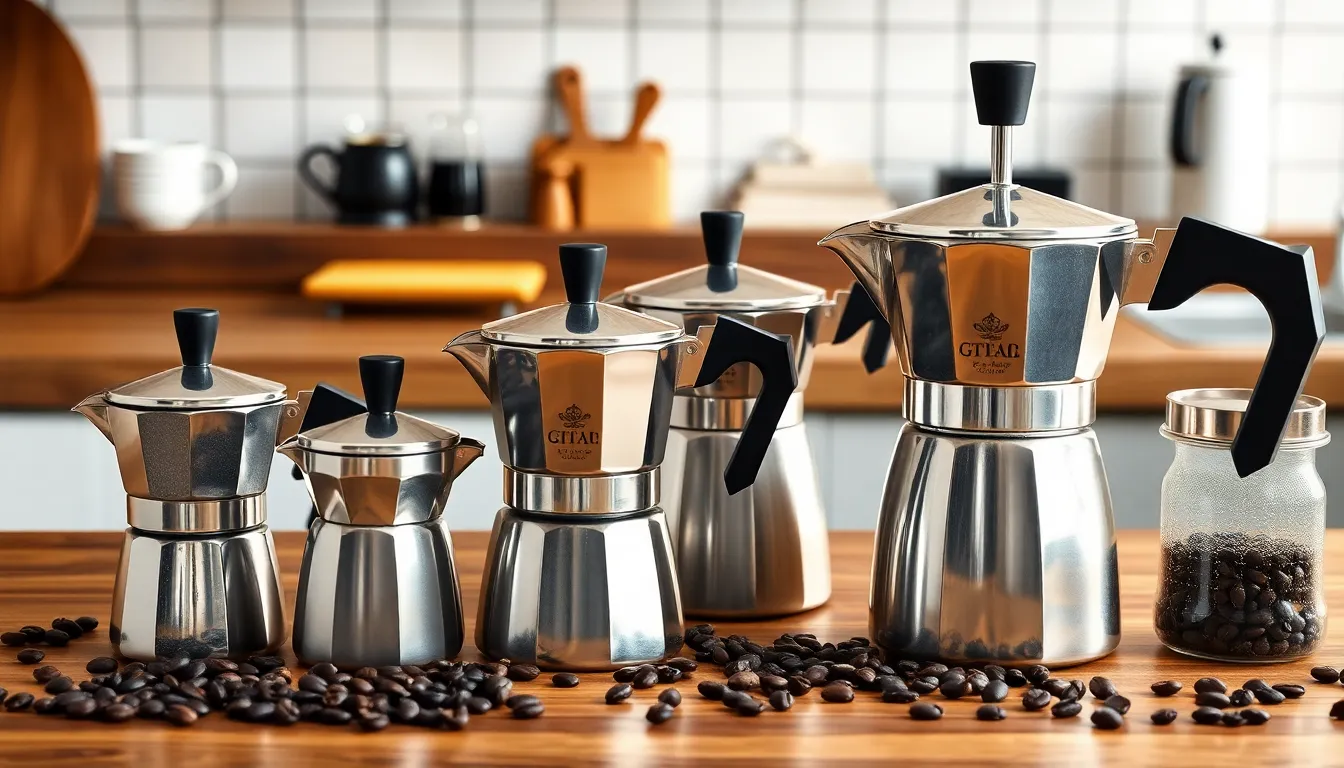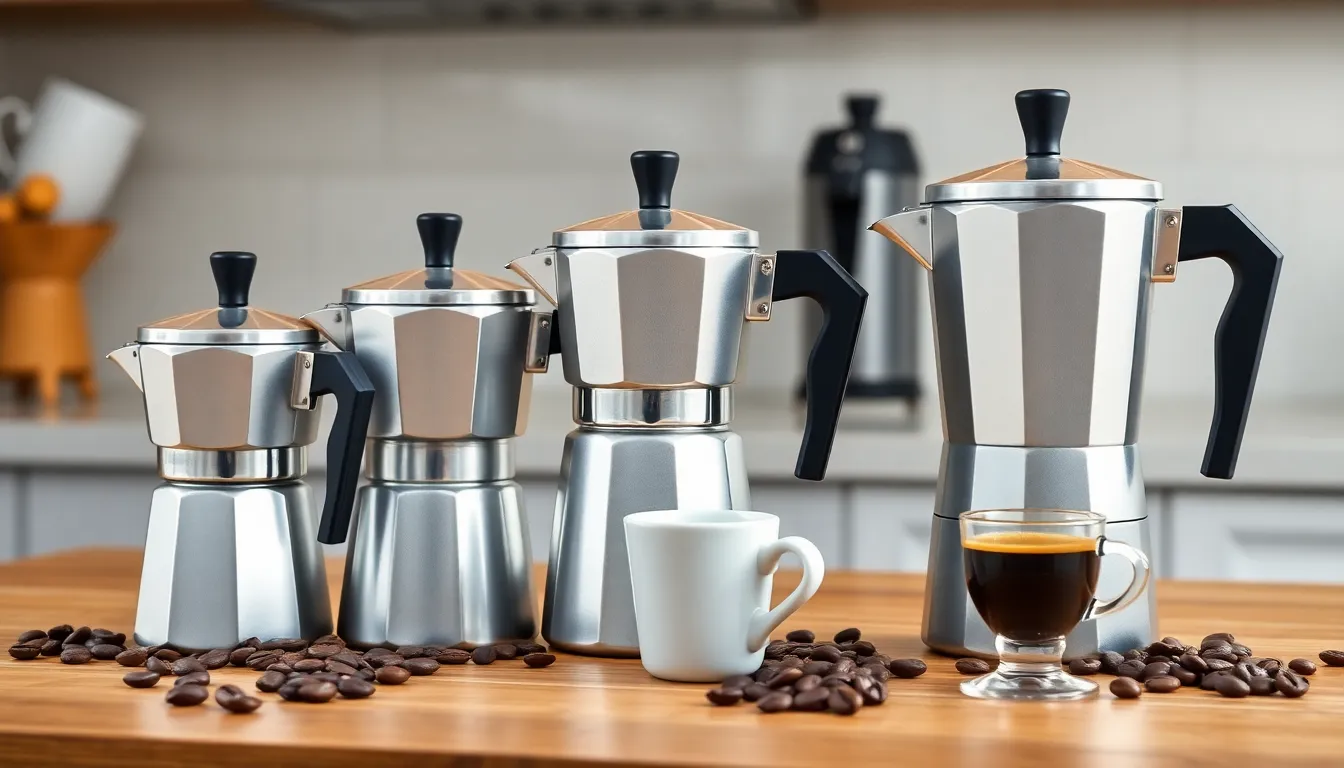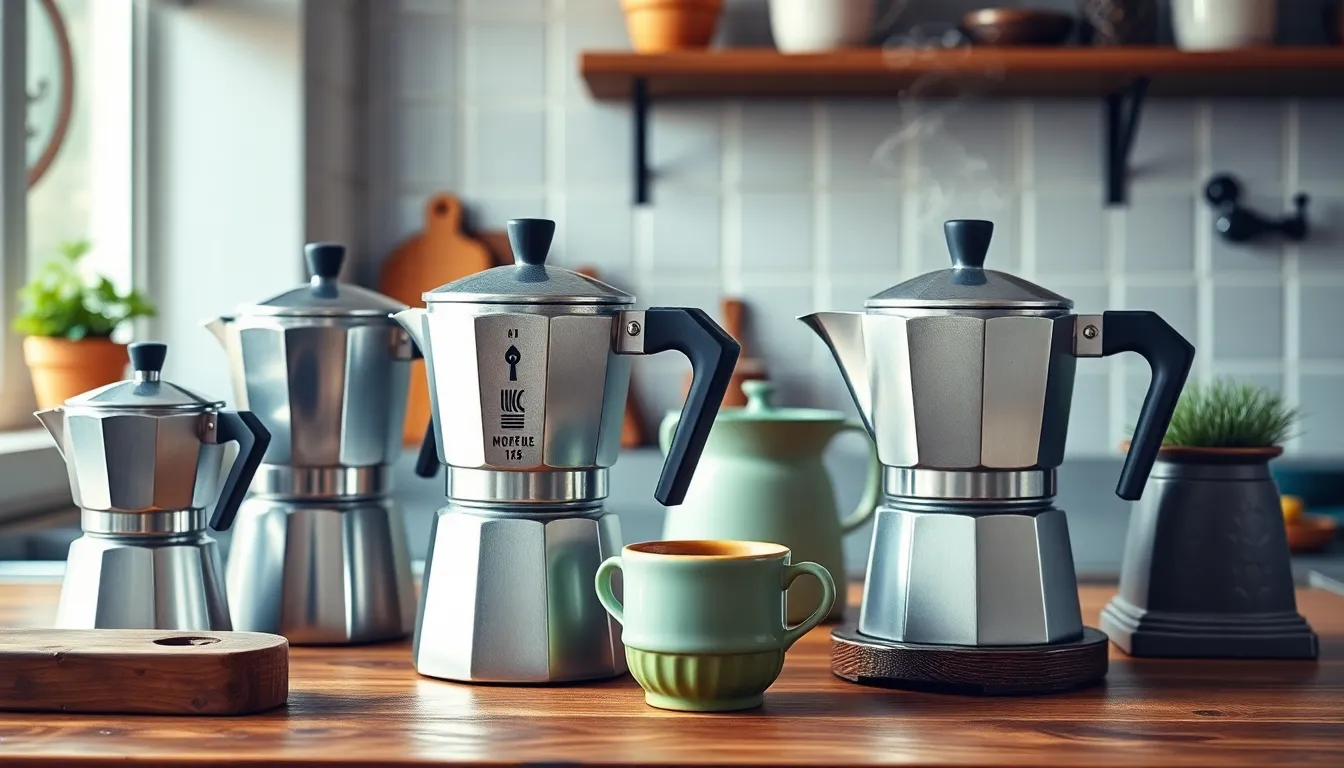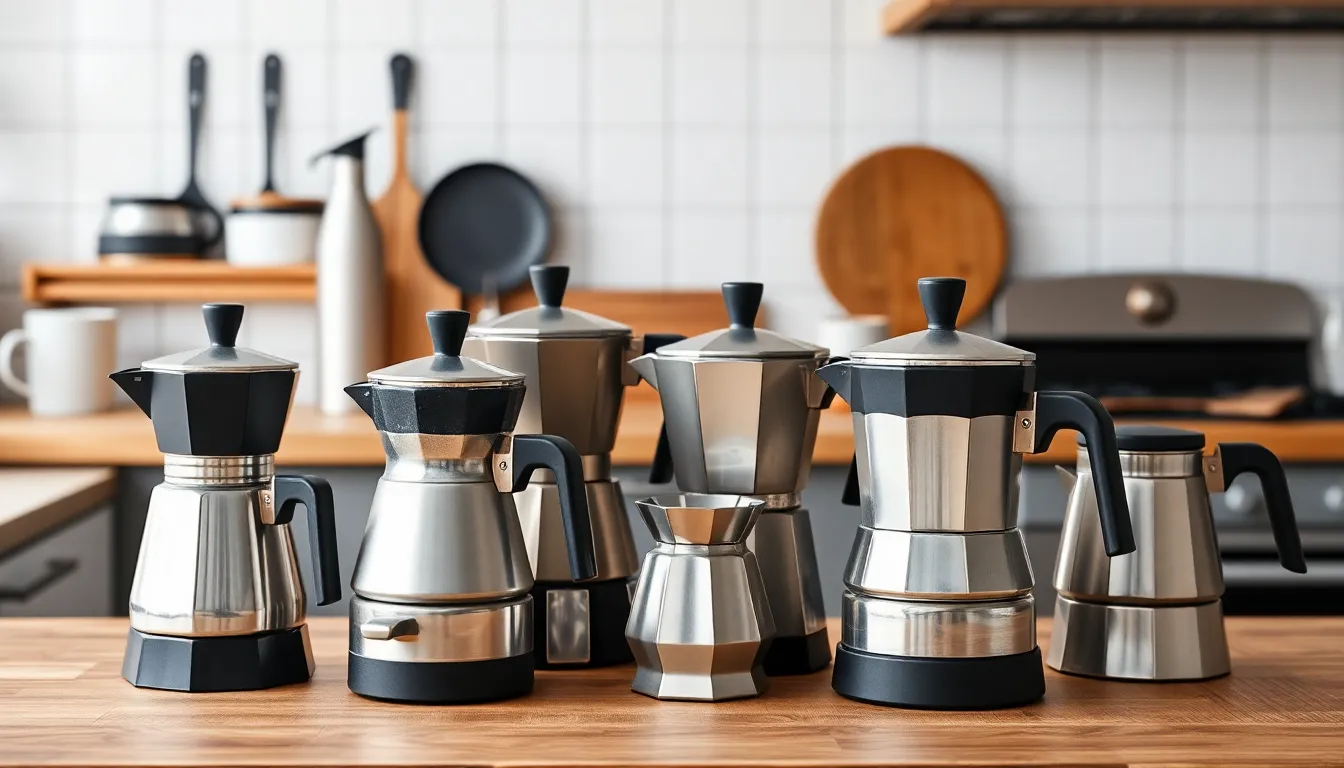Wondering which moka pot size is right for your morning coffee ritual? Choosing the perfect size can make all the difference between a satisfying brew and a disappointing cup.
Moka pots come in various sizes, typically measured in “cups”—though these aren’t standard coffee cups but rather small espresso-sized servings. From the tiny 1-cup model perfect for solo drinkers to the generous 12-cup version designed for entertaining, there’s a size for every coffee lover’s needs. You’ll need to consider not just how many people you’re serving, but also your preferred coffee strength and daily consumption habits.
What Is a Moka Pot?
A Moka pot is an iconic stovetop coffee maker invented by Alfonso Bialetti in 1933. These octagonal aluminum brewers create a rich, concentrated coffee that’s stronger than drip coffee but not quite as intense as espresso. Many coffee enthusiasts appreciate Moka pots for their ability to produce full-bodied coffee with a distinctive flavor profile without requiring expensive equipment.
The brewing process involves water pressure forcing hot water through coffee grounds. As water heats in the bottom chamber, pressure builds and pushes water upward through the coffee grounds in the middle basket. The brewed coffee then collects in the upper chamber, ready to serve.
Moka pots operate on simple principles yet deliver complex flavors. They’re typically made from aluminum or stainless steel, with the traditional design featuring the distinctive eight-sided shape that has become synonymous with stovetop brewing. These durable coffee makers often last for decades when properly maintained, making them a sustainable choice for daily coffee preparation.
The popularity of Moka pots extends worldwide, with particular cultural significance in Italy, where they’re a household staple. Their affordability, ease of use, and ability to create consistent coffee have contributed to their enduring appeal across generations of coffee lovers.
Understanding Moka Pot Sizes

Moka pot sizes are measured in “cups,” but these aren’t standard coffee cups. One “cup” equals approximately 50 milliliters (2 fluid ounces) of strong espresso-style coffee, much smaller than a typical American coffee cup. This sizing system reflects the Italian origin of the moka pot, where small, concentrated servings are traditional.
1-Cup Moka Pot
The 1-cup moka pot produces about 50-60 ml (2 oz) of coffee, perfect for a single espresso-sized serving. It’s an extremely compact option that fits easily in small kitchens or travel bags. Solo drinkers who enjoy one strong shot at a time find this size ideal for their daily ritual without wasting any coffee. The brewing process takes just a few minutes, making it convenient for quick morning routines.
3-Cup Moka Pot
A 3-cup moka pot delivers roughly 130-150 ml (4.4-5 oz) of coffee, enough for one to two espresso-sized cups. This popular size strikes a balance between compactness and volume, giving you a bit more coffee than the smallest option. It’s particularly suited for individual use throughout the day or for sharing a modest amount with a companion. Many coffee enthusiasts consider this the “goldilocks” size for regular home use.
6-Cup Moka Pot
The 6-cup model yields around 250-300 ml (8.5-10 oz) of coffee, comfortably serving two to three people. This medium-sized option has become a household favorite for small families or couples who enjoy coffee together. It provides enough volume for a satisfying morning brew without requiring multiple batches. The 6-cup size also works well for filling a travel mug if you prefer to take your coffee on the go.
9-Cup Moka Pot
With a capacity of about 400-440 ml (14-15 oz), the 9-cup moka pot serves approximately four to five espresso-sized portions. This larger size accommodates gatherings or families with several coffee drinkers. It’s particularly useful for weekend brunches or after-dinner coffee service when entertaining guests. The 9-cup model maintains the characteristic moka pot flavor while scaling up the quantity for more generous serving needs.
12-Cup Moka Pot
The 12-cup moka pot, the largest standard size, produces approximately 590-600 ml (20 oz) of coffee, delivering about six to seven servings. This substantial capacity makes it ideal for larger gatherings, offices, or coffee-loving households. Even though its larger size, it operates on the same principles as its smaller counterparts, maintaining the distinctive rich flavor moka pots are known for. Many coffee shops and cafés use this size as their go-to option for serving multiple customers efficiently.
| Moka Pot Size | Approximate Coffee Volume | Typical Use Case |
|---|---|---|
| 1-Cup | 50-60 ml (2 oz) | Single strong espresso shot |
| 3-Cup | 130-150 ml (4.4-5 oz) | Solo drinker wanting more volume |
| 6-Cup | 250-300 ml (8.5-10 oz) | Small households, 2-3 servings |
| 9-Cup | 400-440 ml (14-15 oz) | Larger groups, 4-5 servings |
| 12-Cup | 590-600 ml (20 oz) | Big gatherings, 6-7 servings |
How Moka Pot Sizes Actually Translate to Servings

Moka pot sizes indicate the number of espresso-style servings they produce, not standard coffee cups. Each “cup” measurement equals approximately 50 milliliters (about 2 US fluid ounces) of concentrated coffee, reflecting traditional Italian espresso portions.
The 1-cup moka pot delivers about 2 oz (60 ml) of coffee, equivalent to a single espresso shot—perfect for a quick caffeine fix. Moving up to a 3-cup model yields around 6.5 oz (130 ml), making it ideal for individual use when you want a bit more than just one shot.
For households or coffee enthusiasts who enjoy larger servings, the 6-cup moka pot provides approximately 10 oz (250 ml), sufficient for about 5 espresso-sized servings. Groups or families benefit from the 9-cup version, which produces roughly 18.5 oz (410 ml) of rich, concentrated coffee.
Larger gatherings can be served with a 12-cup moka pot, generating close to 25 oz (595 ml) of coffee. Extra-large models like 18-cup moka pots can brew up to 27 oz (800 ml), serving many coffee drinkers at once.
Remember that moka pots perform best when their coffee basket is completely filled with grounds. Brewing with a partially filled basket often results in subpar taste and extraction quality. The concentrated nature of moka pot coffee means you might prefer consuming it in smaller portions, even if you typically enjoy larger coffee servings.
Single users typically find the 3-cup size offers the perfect balance between quantity and optimal flavor extraction. Households with multiple coffee drinkers or those who entertain guests regularly will appreciate the 6-cup or 9-cup versions, eliminating the need to brew multiple batches for everyone to enjoy.
Choosing the Right Moka Pot Size for Your Needs

Selecting the appropriate moka pot size directly impacts your coffee brewing experience. The perfect size ensures optimal flavor extraction while producing just the right amount of coffee for your exact situation.
For Solo Coffee Drinkers
Solo coffee enthusiasts benefit most from 1-cup to 3-cup moka pots. These compact brewers produce between 60 ml (2 oz) to 130 ml (4.4 oz) of rich, concentrated coffee per brewing session. The 3-cup model often represents the sweet spot for individual coffee lovers, delivering enough strong coffee for a satisfying morning ritual without wastage. Small-sized pots guarantee complete basket filling with each use, which proves crucial for extracting maximum flavor from your grounds. Many customers find that the 1-cup version makes an ideal travel companion, while the 3-cup offers more flexibility for those mornings when you need an extra caffeine boost.
For Couples and Small Households
Couples and small households thrive with 4-cup to 6-cup moka pots. These medium-sized brewers yield approximately 185 ml (6.3 oz) to 250 ml (8.5 oz) of coffee, perfect for sharing between 2-3 people. The 6-cup moka pot stands out as particularly popular among couples because it strikes an excellent balance between quantity and coffee strength. Some coffee enthusiasts maintain two different-sized pots—a smaller one for quick personal brews and a larger one for mornings together—maximizing brewing flexibility based on daily needs. The 4-cup size works wonderfully for couples who prefer more moderate coffee portions while still enjoying the moka pot’s distinctive rich flavor profile.
For Families and Entertaining Guests
Families and those who frequently entertain should consider 9-cup to 12-cup moka pots. These larger models produce between 410 ml (14 oz) to 595 ml (20 oz) of coffee, accommodating multiple servings in one brewing cycle. The 9-cup size proves especially practical for gatherings, ensuring everyone enjoys fresh coffee without requiring multiple brewing sessions. Larger households appreciate these generous sizes for weekend brunches when everyone wants coffee simultaneously. Coffee enthusiasts hosting dinner parties often find the 12-cup version creates just enough strong coffee to serve as the base for after-dinner coffee drinks. Remember that larger pots perform best when filled to capacity—brewing smaller amounts in oversized pots may result in suboptimal flavor extraction and weaker coffee.
Maintenance and Storage Considerations for Different Sizes

Maintaining your moka pot properly ensures its longevity and consistent coffee quality regardless of its size. Different sized pots require slightly different approaches to cleaning, maintenance, and storage due to their physical dimensions and brewing capacities.
Cleaning Different Sized Moka Pots
Daily cleaning routines remain similar across all moka pot sizes but scale with volume. After each use, rinse your pot thoroughly with hot water and dry completely to prevent mineral buildup and corrosion. Avoid using soap or detergents as they strip away the coffee oils that enhance flavor over time.
Smaller 1-3 cup moka pots are easier to clean due to their compact size and fewer components. These pots typically take less time to disassemble and dry completely. Larger 9-18 cup models require more attention during cleaning as they have more surface area and sometimes additional components to manage.
For deep cleaning, which should be done monthly:
- Disassemble all components completely
- Soak parts in a mild vinegar solution to remove stubborn coffee residue
- Gently scrub interior surfaces with a soft brush
- Rinse thoroughly with warm water
- Dry each component meticulously before reassembly
Component Replacement and Maintenance
The rubber gasket and filter screens in your moka pot eventually need replacement regardless of pot size. These parts typically last 6-12 months depending on frequency of use and water quality. After installing new components, run several brewing cycles with just water to season the pot and stabilize coffee flavor.
Larger moka pots often have thicker gaskets and larger filters that may cost more to replace but generally follow the same replacement schedule as smaller models. The valve systems in larger pots sometimes require additional inspection to ensure they’re functioning properly.
Storage Answers by Size
Storage requirements vary significantly based on moka pot dimensions:
1-3 cup pots:
- Fit easily in standard kitchen drawers
- Require minimal vertical clearance in cabinets (typically under 6 inches)
- Can be stored fully assembled due to their compact size
6-9 cup pots:
- Need medium cabinet space with approximately 8-10 inches of vertical clearance
- May be too tall for some standard drawers
- Best stored partially disassembled in smaller kitchens
12-18 cup pots:
- Require dedicated storage space with important vertical clearance (12+ inches)
- Too large for standard drawers
- Should be stored with the lid slightly open or disassembled to allow airflow
All sizes benefit from storage in dry environments to prevent moisture accumulation that can lead to mold or corrosion. For kitchens with limited space, smaller moka pots offer practical advantages beyond just serving size considerations.
Proper maintenance paired with appropriate storage ensures your moka pot delivers exceptional coffee for many years, regardless of which size best suits your needs.
Conclusion
Choosing the right moka pot size transforms your coffee experience from good to exceptional. Whether you opt for a compact 1-cup model for solo mornings or a generous 12-cup version for entertaining friends your selection should align with your exact needs.
Remember that moka pots perform best when filled to capacity so it’s better to go smaller than larger if you’re unsure. The 3-cup size offers versatility for individual drinkers while 6-cup models work well for small households.
With proper maintenance and storage your moka pot will deliver rich flavorful coffee for years to come. The perfect size balances convenience practicality and your coffee consumption habits ensuring you’ll enjoy that distinctive moka pot brew exactly as intended.
Frequently Asked Questions
What is a moka pot?
A moka pot is an iconic stovetop coffee maker invented by Alfonso Bialetti in 1933. It produces rich, concentrated coffee that’s stronger than drip coffee but not quite espresso. These durable brewers, typically made from aluminum or stainless steel, use water pressure to force hot water through coffee grounds, creating a full-bodied brew with distinctive flavor. They’re particularly beloved in Italy and known for their affordability and consistency.
How do moka pot “cups” translate to actual coffee servings?
Moka pot “cups” refer to small espresso-sized servings (approximately 50ml or 2oz each), not standard coffee cups. A 1-cup moka pot yields about 60ml (2oz), while a 3-cup model produces around 130ml (4.4oz). A 6-cup version makes about 250ml (8.5oz), a 9-cup brews approximately 410ml (14oz), and a 12-cup model delivers around 595ml (20oz) of coffee.
What size moka pot is best for a single person?
For a solo coffee drinker, a 1-cup to 3-cup moka pot is ideal. While the 1-cup model provides a single espresso shot (about 60ml/2oz), the 3-cup version is often the preferred choice as it offers a more satisfying amount (about 130ml/4.4oz) without being excessive. The 3-cup size strikes a good balance between quantity and the rich flavor moka pots are known for.
What size works best for couples or small households?
Couples and small households typically benefit from 4-cup to 6-cup moka pots. These sizes brew approximately 185ml (6.3oz) to 250ml (8.5oz) of coffee, providing enough for two people to enjoy a moderate serving each. The 6-cup model is particularly versatile, offering enough coffee for two larger drinks or several smaller espresso-style servings.
Should I get a 9-cup or 12-cup moka pot for family use?
For families or those who regularly entertain guests, 9-cup to 12-cup moka pots are recommended. The 9-cup model produces about 410ml (14oz) of coffee, while the 12-cup version yields approximately 595ml (20oz). These larger sizes ensure everyone gets a serving without brewing multiple batches, making them perfect for morning family routines or gatherings.
Can I brew smaller amounts in a larger moka pot?
While technically possible, brewing smaller amounts in an oversized moka pot isn’t recommended. Moka pots perform best when the coffee basket is fully filled with grounds. Using a partially filled basket often results in subpar taste and weaker coffee. For optimal results, choose a moka pot size that matches your typical brewing needs rather than occasionally brewing less in a larger pot.
How do I properly maintain my moka pot?
Proper maintenance involves regular cleaning after each use by rinsing with hot water (no soap) and thoroughly drying all components. Periodically, conduct a deeper cleaning by disassembling the pot and removing coffee oils with a soft brush. Replace the rubber gasket and filter screen annually or when showing wear. Never clean aluminum moka pots in a dishwasher, and always store in a dry place.
Does a larger moka pot require more maintenance?
Larger moka pots (9-18 cups) require somewhat more attention during cleaning due to their size and coffee volume, but the maintenance process remains similar across all sizes. The main difference is the scale of cleaning—larger surface areas and more coffee residue to remove. However, component replacement schedules (gaskets, filters) remain consistent regardless of pot size.
How does moka pot coffee compare to espresso?
Moka pot coffee is stronger and more concentrated than drip coffee but not as intense as true espresso. While espresso machines produce 9 bars of pressure, moka pots generate only 1-2 bars, resulting in a rich brew that lacks the crema characteristic of espresso. However, moka pots deliver excellent flavor concentration and body at a fraction of the cost of espresso machines.
Are stainless steel moka pots better than aluminum ones?
Both materials have advantages. Stainless steel moka pots are more durable, dishwasher-safe, don’t impart metallic flavors, and work on induction stovetops. Aluminum models are lighter, less expensive, and have better heat conductivity for faster brewing. Stainless steel pots tend to last longer, while aluminum ones develop a seasoned quality over time that many coffee enthusiasts appreciate.

